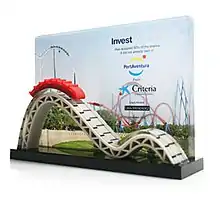
A deal toy (also deal gift, lucite tombstone or financial tombstone) is a customized memento or gift that is intended to mark and commemorate the closing of a business deal in finance or investment banking. These plaques or other types of trophies are typically presented at the closing ceremony or dinner to the issuer and senior third-party advisers of the major financial transactions as a souvenir.[1]
History
The deal toy is the marriage of a design with the tombstone advertisement, a term that dates to the late 19th century, when printers used it to refer to "column-width newspaper ads run without any illustration or typographical ornamentation." Restrictions imposed by the Securities Act of 1933 meant that the tombstone ad became the format that companies and banks used to publicize financial transactions such as initial public offerings. From at least the late 1960s, law firms and banks produced Lucite slabs that encased the tombstone ads announcing new partner classes. By the early 1970s, deal closings were being similarly immortalized.[2][3]
As a result of the banking crisis of 2008, investment banks closed fewer deals, and deal toy budgets were reined in accordingly.[4]
Purpose

Deal toys are designed to commemorate a financial transaction.[5] This memento is described as an ad hoc creation to a financial offering or other major investment banking transaction and is most often presented at the closing ceremony of the deal.[6]
This souvenir typically includes the names or logos of the firms for which the transaction is completed (the recipients), description of the transaction (type, size and, date of the deal) as well as the names and or logos of the key financial advisors and financiers involved in that transaction. Because the recipients of the award are the clients of the advisors and financiers, the award also acts as a marketing tool for the presenter long after the transaction has passed.
As deal toys became used within the investment banking industry, they also became a point of pride—and competition—with firms frequently seeking to outdo each other with creative and elaborate designs.[7]
The banking crisis of 2008 caused many financial firms to rein in spending generally, and on deal toys specifically.[4] Though many financial firms have recently eased restrictions on tombstone budgets, they largely have not been restored to pre-crisis levels. Average order size, which had ranged between 50-60 pieces prior to 2008, had by 2013 stabilized at around 20-30. Order quantities can still reach approximately 50 or 60 for larger transactions.[4]
3D printing

Deal toys can be manufactured by 3D printing, which allows the creation of beautiful and complex tombstones compared with more conventional materials. The materials used for 3D printing a deal toy are polyamide and resin. These are often used in combination with other materials like, wood, stone, steel or acrylic.
Status
Deal toys are generally considered to be prized by the recipient, indicating achievement. Deal toys possessed by an individual can also serve as a reflection of his or her status, as they indicate the number of transactions with which they have been involved. They are displayed to help persuade potential clients to work with a firm on their transaction.[8]
See also
References
- ↑ Espinasse, Philippe (2014). IPO: A Global Guide (Second ed.). Hong Kong University Press. p. 314. ISBN 9789888083190. Retrieved 29 December 2014.
- ↑ Goodman, Leah McGrath (25 February 2008). "Seal that deal with ... a toy". Financial Times. Archived from the original on 2022-12-11. Retrieved 23 December 2021.
- ↑ Marcus, David (10 January 2015). "Tracing the History of 'Deal Toys' from Lucite to Brass Balls". TheStreet. Retrieved 19 February 2018.
- 1 2 3 Little, Katie (5 March 2013). "Wall Street 'Toy' Indicator Flashes a Bullish Sign". CNBC. Retrieved 19 February 2018.
- ↑ Sturgeon, Ron (2005). Business Jargon. M. French Publishers. p. 111. ISBN 9780971703117. Retrieved 21 December 2014.
- ↑ Burch, John C.; Foerster, Bruce S., eds. (2005). Capital Markets Handbook. Aspen Publishers. p. GL-40. ISBN 9780735550322. Retrieved 29 December 2014.
- ↑ Dugan, Ianthe Jeanne (11 February 2009). "Another Wall Street Casualty: The Art of the 'Deal Toy". The Wall Street Journal. Retrieved 19 February 2018.
- ↑ McGee, Suzanne (17 March 2014). "Toys for Titans: How Wall Street Celebrates Its Deals". The Fiscal Times. Retrieved 19 February 2018.
External links
- Valdmanis, Thor (16 February 2004). "Lucite monuments pop up to mark increase in mergers, acquisitions". USA Today.